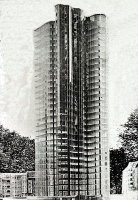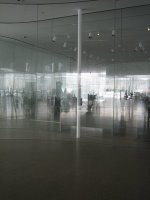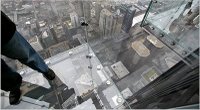This week, the NY Times covered the new overhanging glass observation pods at the Sears Tower. Given the article by Henry Fountain which focused on the material quality of this glass, I decided to do a quick refresher of architectural glass usage and its conceptual implications. While structural progress in glass technology is remarkable, the use of glass in the Sears Tower is minimally groundbreaking. Below is a brief history of major transitions in architecture as a result of the medium of glass.
1.  2.
2. 
1. Joseph Paxton – Crystal Palace London, England. 1851 In the Crystal Palace, Paxton revolutionized production in the architectural process. Time for fabrication and assembly was totally reconsidered and made possible by the lightweight materials of iron and glass. A glass enveloped structure was not only lightweight, but could be produced quickly in the industrialized heart of England. The other advantage to using so much glass was a bewildering amount of daylight could be let into the massive structure, eliminating the need for massive amounts of supplemental lighting. The Crystal Palace still is a landmark project for the extent of its glass use and natural lighting.
2. Bruno Taut – Glashaus Cologne, Germany, 1914 When presented at the 1914 Werkebund Exhibition, this project received the gamut of responses from critics (Gutschow, 2006) Taut’s temporary pavilion highlighted the experiential capability of glass. Architectural historian Kai Gutschow has commented that this project transformed glass from a construction novelty to an ephemeral and inspiring material. Gutschow notes that Taut and his contemporaries, ”conjured up a utopian, visionary ‘glass architecture’ (Glasarchitektur) that was flexible and mobile, floating and towering, gleaming and transcendent, and that was allied with a modern political and social agenda.” (Gutschow, 2006) The Glashaus encapsulated the ephemeral quality of glass, moving beyond the industrial showcase of Paxton’s work. An ability to astound and bewilder with the refraction and color of glass was central to the Glashaus and remains a strong selling point for glass today. No one before Taut was able to bring such a experience to bear in a single place.
3.  4.
4. 
3. Mies Van de Rohe – Glass Skyscraper Unbuilt 1921-22 The cultural experience of the Chicago Tribune Tower competition of 1922 highlighted a prevalent conservative architectural tendency. The selection of a skyscraper designed to take the form of Gothic-pastiche, enraged many architects and critics. During the midst of this debate Mies produced his drawings for the Glass Skyscraper. His rejection of historicist form for a newly invented typology, the skyscraper, presented the revolutionary vision that the Tribune Tower had not. . Created before his major built works in Stuttgart and Barcelona, Mies’ conceptual drawing pioneered new ideas on transparency. A skyscraper should be as pronounced in its transparency as in its height. As workers ascend to the higher stories, so too should there be an increase in the ability to see beyond the drab of street and view the wider world. The promise of a socialist and machine driven society, where transparency symbolizes equality, shines so brightly in these drawings. The revolutionary politics of the glass skyscraper have passed, but the paradigm of a skyscraper typology requiring transparent cladding still dominates modern construction.
4. Philip Johnson – Glass house New Canaan, Connecticut. 1949 The project is often rebuked as a copy of the Farnsworth House built by Mies at the same time; however, this would be a simple mistake. As a project, the Glass House extols the vision projected by Mies in his drawings of the Glass skyscraper, but Johnson is able to complete the vision by maintaining a small scale. Completely transparent, the glass envelope situates the project within its natural context. Whereas the Farnsworh House is separated from nature, Johnson’s house in conjoined to the surroundings. This relationship is visible in the plan layout. A coplanar relationship of structure to the glass walls is a notable difference between Mies and Johnson. Compressing the Glass House structure as the literal frame for the glass minimized the material and visual divide between inside and outside. The circular brick bathroom is the only non transparent element. This, clearly visible in a drawing, demonstrates that while Mies’ Farnsworth glass pronounces a seeing out, Johnson felt that seeing in, through glass, is equally important.
5.  6.
6. 
5. SANAA - Glass Pavilion Toledo, Ohio. 2006 Bringing about the first major shift in considering glass in nearly a century, SANAA reconsidered the rules of glass at this building in Ohio. Instead of expanding the dialogue about the transparency of glass, this project is an examination of its opacity. Thin glass used for nearly all internal walls bends and curves to form rooms and corridors. As these curves bend in, the light also bends and refracts. Visitors glimpse across the space, but are obstructed from seeing the full picture. SANAA’s forms give sensuality straight from Corey Hart’s Sunglasses at Night. The mystery is not from total obstruction, but by using a simple glass manipulation against the surrounding light to create opacity.
6. Halcrow Yolles/SOM – Sears Tower Observation Deck Chicago, Illinois. 2009 As discussed, the conceptual ideas on transparency in this project are not new. Excitement is not even because of an innovative material property. The material efficiency of the structural glass at the Sears Tower is impressive; however, Apple Stores and other installations have been experimenting with this process for years, so even this is only moderately innovative. What the Sears Tower project does innovate on is a marketing sense. Glass boxes and stairs at Apple Stores are impressive, but not monumental. Despite the architectural wonder of SANAA’s work, it is doubtful that many people understand its deeper significance. These obstacles of surprise and significance are overcome by the Sears Tower project because of the precipitous drop over which they are placed. The material itself is not so significant as the experience of finally being part of a death defying experience. No doubt the acrophobia is more impressive than the architecture. Marketing this, rather than revealing new ideas about glass is the underlying topic of the NY Times article and the Sears Tower’s ad campaign. Childlike amazement at standing ‘precipitously’ will no doubt attract more visitors and queries than other of these other architectural achievements. That alone should make the Sears Tower’s designers very happy. See the NY Times articleand attached photos for more information.
CITATIONS
Gutschow, K. (2006). From Object to Installation in Bruno Taut's Exhibition Pavilions. Journal of Architectural Education , 59, 63-70.
-----
Via Jargon
Personal comment:
Du fait que l'on utilise pour l'instant souvent le verre dans nos projets, intéressant de se replonger dans une "short history" du matériau et de son utilisation dans des projets de "statement".






